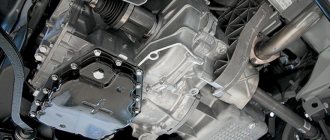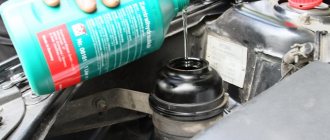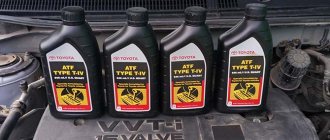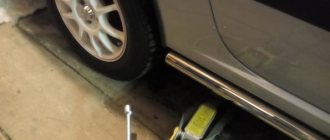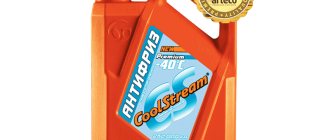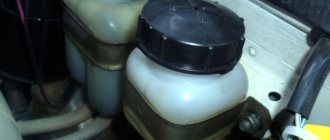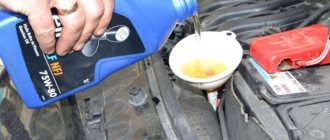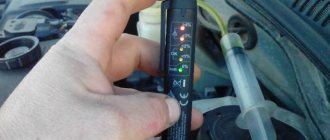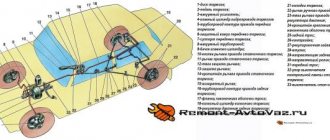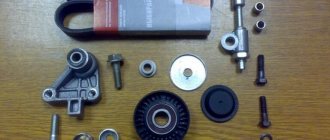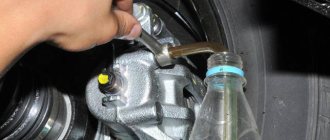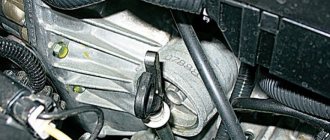The manufacturer recommends changing the brake fluid in the hydraulic brakes of the Lada Granta after 3 years of operation or 45 thousand km. mileage (whichever comes first). As a rule, this procedure is performed at a service station, but if you wish, you can service the VAZ 2190 brakes yourself.
You will need : an 8′ wrench for pipeline nuts, brake fluid, a rubber or transparent hose, a transparent container, a syringe or a rubber bulb.
For reference: Brake fluids used in the hydraulic brake drive system:
| ROSDOT | LLC 'Tosol-Sintez', Dzerzhinsk | TU 2451-004-36732629 |
| KAPROS-DOT | LLC 'Sibur-Neftekhim', Dzerzhinsk | TU 2451-030-52470175 |
Replacing brake fluid Lada Granta
Procedure:
Unscrew the master cylinder plug. Pump out the old brake fluid from the reservoir with a syringe or rubber bulb and fill with new DOT-4 brake fluid to the bottom edge of the reservoir filler neck. If the rear wheels are suspended, then first unlock the brake force regulator of the rear brake mechanisms. To do this, you need to insert a screwdriver between the plate and the piston (remove it when finished). Clean the air release valve of the right rear brake mechanism from dirt. Remove the rubber protective cap from the valve. Place a rubber hose (preferably transparent) onto the valve fitting and lower its end into a clean transparent container.
The assistant must sharply press the brake pedal 4 or 5 times (with an interval of 1-2 seconds), and then keep the pedal pressed. After which: Unscrew the air release valve 0.5-0.75 turns, and old (dirty) brake fluid will begin to flow out of the hose. The brake pedal should smoothly reach the stop. Close the valve after the liquid stops flowing. Constantly monitor the fluid level in the reservoir, do not allow it to fall below the 'MIN' mark. If necessary, add new brake fluid. Repeat steps 1-2 until clean brake fluid flows out of the hose. In a similar way, replace the brake fluid in the left front brake mechanism, and then in the second circuit (first in the left rear, then in the right front).
Finally, press the brake pedal several times. Grant brakes will perform their function when the pedal travel and resistance are constant with each application. If these conditions are not met, then air has entered the brake system and it needs to be bled.
Types and types of ABS anti-lock systems
Based on the number of control circuits, there are three types of anti-lock braking systems:
- single-channel - when one wheel is blocked, all four are released;
- two-channel - triggering occurs based on data from the best (high-threshold) or worst (low-threshold) wheel;
- four-channel - each wheel is adjusted separately, which ensures maximum braking efficiency.
Important! Modern cars are equipped with four-channel systems.
Depending on the location of components and maintenance features, there are three types of ABS:
- with components (hydraulic module, valves, accumulator and pump) located in a single unit;
- with components spaced in the form of different units;
- with optional SBC and ESP systems.
Despite the complicated design, it is quite possible to replace ABS brake fluid yourself.
How to change brake fluid
It is best to do this at specialized service stations. Most modern cars have an ABS system, and this leaves its mark on the procedure. Special equipment is required to pump the system with new fluid.
If you are told that you can change brake fluid without bleeding without special equipment, then do not listen to this advice. Yes, on some wheels the pressure from the reservoir can push through the system, but on all of them this will not happen. As a result, air or old fluid will remain in the system. At service stations, fluid is replaced under pressure, so subsequent pumping is not required.
The replacement procedure itself is as follows. New fluid is poured into the empty expansion tank of the cooling system, after which pumping occurs on each line, during which the new fluid displaces the old one.
The average brake fluid volume ranges from 0.75 to 1.3 liters.
Changing brake fluid without special equipment is clearly described in the video below:
How to properly and quickly bleed ABS brakes with your own hands
The procedure for bleeding the brakes is influenced by the design of the system, the location of components and the presence of additional electronic modules. The correct sequence is important. You need to start by relieving the pressure in the hydraulic accumulator. To do this, you need to turn off the ignition (it is not necessary to start the engine) and pump the pedal.
A simple secret to quickly pumping brakes. Video:
Read how to bleed ABS brakes and stock up on the following materials, parts, accessories and tools:
Differences between ABS brakes
The main difficulty lies in ignorance of the nuances of operation and the main differences from the same procedure on conventional brakes.
Different car models have their own types of ABS, the design of which differs from each other. This leads to the fact that each brand of car has its own nuances of the system bleeding procedure.
Bleeding brakes with ABS has three main differences from conventional ones:
- the pipeline system in the presence of ABS is under increased pressure;
- During the procedure, constant monitoring of the brake fluid level will be required;
- the pump runs for no more than 10 minutes.
If you do not control the brake fluid level in the system, it will reach a critical minimum and the drive pump will begin to pump air.
This will quickly damage the device.
If the pump runs longer than the set 10 minutes, turn off the ignition and allow the unit to cool for 10-15 minutes.
What is the volume of the Lada Granta tank?
Lada Granta is a fairly popular car among Russian consumers.
Its price is reasonable, and operation is much cheaper than a foreign car. However, not all owners can accurately indicate the main parameters of this machine. In this article we will tell you what the volume of the fuel tank in the Lada Granta is.
A little about Grant
As you know, the manufacturer created the Lada Granta based on an earlier model, the Kalina. The car is now supplied to the market in four modifications:
There are also three types of configuration. Both the luxury version and the “Standard” and “Norma” are equipped with 1.6-liter engines of varying power. At first, the car was supplied with power plants with 8 valves, but then 16 valves appeared.
All modifications use a 5-position gearbox. It can be automatic or manual. The front wheels are driven.
The manufacturer recommends using only AI-95 for refueling, but many claim that the car feels great when running on 92.
According to the standard, fuel consumption per hundred kilometers is:
- in urban conditions – 8.7-9.3;
- on highways – 5.8-6.2;
- mixed cycle - 7.2-7.3 liters.
Granta is able to reach a maximum speed of more than 168 kilometers per hour. It needs a maximum of 12 seconds to accelerate to hundreds.
The gasoline tank is installed behind the Grant, under the body, on the right side. This arrangement allows the car to be perfectly balanced, which, in turn, makes it easier to drive. The fuel tank is made of plastic.
Among other things, the designers also made certain changes to the suspension design during the development of the car in question. In particular, a wider caster was installed in the front, this had a positive effect on the vehicle's directional stability.
- At the same time, the steering rack was also updated; it is now somewhat shorter than the one installed on Kalina, thanks to this, only three turns of the steering wheel are required for a full turn. This made driving the car much easier
- The front suspension also has a new strut module, whose design has undergone a number of changes and has received completely new characteristics as a result.
- The stabilizers that provide lateral stability are stronger, as are the body supports.
During the modernization, attention was also paid to the rear suspension. So Granta became the first car in the history of the Volzhsky Automobile Plant to have negative wheel camber values. And this measure greatly improves the vehicle's handling.
What is the volume of the gas tank
Regardless of the modification of the Grant, the volume of its fuel tank is the same and is exactly 50 liters.
To this amount of gasoline should be added about 2 liters already supplied to the fuel supply system and the fuel filter. As a result, the maximum fuel for Grant will be 52 liters.
As previously noted, the car manufacturer indicates that only 95 gasoline should be used. In turn, reviews indicate that the car drives much more economically with this brand than with the cheap 92. Although critics note that they have no problems with the latter type of fuel - studies have proven that in total, their expenses (albeit insignificantly) , but higher.
It should also be remembered that it is advisable to fill the tank full only in situations where a long journey is ahead.
Otherwise, the money spent on fuel reserves will literally be thrown away.
The thing is that, under the influence of external factors, the fuel evaporates and escapes into the atmosphere through special holes made in the tank. This process occurs most quickly during the hot season.
As a rule, the refueling nozzle is fired for the first time after 45 liters of fuel have been filled into the tank. At the same time, the indication on the instrument panel will show that the tank is not full by one scale mark.
This circumstance has led to the fact that many car enthusiasts are completely convinced that the Granta’s gas tank is actually smaller than what the manufacturer claims in the accompanying documentation.
But knowledgeable specialists can easily fill up to 6 liters of fuel.
Thus, if you add everything up, it turns out that the total capacity of the gasoline tank in the Grant is at least 51 liters. And this fully corresponds to the assurances of the designers.
When creating the Grant, the factory did not provide for the possibility of draining gasoline from the tank - it does not have a special hole for this. Therefore, if necessary, fuel is removed through a ramp or fuel filter.
The signal about the exhaustion of the gasoline supply is given immediately after its available volume is reduced to 7 liters.
Other filling volumes
This information will be useful to all owners of a Grant car, as it will allow them to more effectively plan the costs of operating the vehicle. So:
- the lubrication system of the power plant has a volume of 3.5 liters;
- for cooling and heating operation you need 7.84 liters of antifreeze;
- Gearbox – 3.1;
- brake hydraulic drives – 0.45;
- windshield washer capacity – 5;
- Fuel tank capacity – 50.
Step by Step Actions
The nuances of pumping depend directly on the ABS model. The location of individual components and the presence or absence of additional modules affect the order of the procedure.
The preparatory stage is the same regardless of the car brand. Turn off the ignition and press the brake pedal intensely several times.
Pumping using the example of Lada Granta
The car is placed on an overpass or driven into a pit. This is necessary so that you do not have to remove the disks for free access to the working surface. Next, turn on the ignition to open the solenoid valves. Start the procedure with the right rear wheel.
To bleed the brakes you need:
- Disconnect the wires from the tank cap;
- remove the cover;
- pour brake fluid into the reservoir (as much as will fit);
- remove the cap;
- use a spanner wrench to loosen the tension on the fitting;
- the prepared hose is connected to the tip of the fitting;
- place the second end of the hose in a container for waste liquid;
- press the brake pedal several times;
- fix the pedal in the lowest position and hold it;
- use a key to open the fitting;
- wait until the liquid has completely drained (at this moment the brake pedal will “fall” to the floor);
- close the fitting;
- pump the pedal again and repeat the procedure until the liquid flowing from the hose no longer contains air bubbles;
- tighten the fitting;
- remove the hose;
- reinstall all parts.
The process is repeated on each wheel in order of priority.
Bleeding the brakes of Lada Priora
The process of bleeding the ABS brake system for the Lada Priora is similar to the previous one. When bleeding the front wheels, the discs are removed, providing better access to the working surface.
After completing the process, you should not immediately drive out onto the road. First, they check the functionality of the system in a safe area, eliminating leaks and failures of the pedal.
Possible mistakes
In order for the procedure to be effective and not lead to new problems, you should know common mistakes. The most common ones include:
- mixing two different brake fluids;
- reducing the fluid level in the system to critical;
- pressure too high.
If you mix two brake fluids with different parameters, the rubber seals are damaged. The system becomes clogged with clots and stops working.
When the fluid level in the reservoir is too low, air gets into the brake system and it fails. Also, do not use excessive force when pumping. The recommended pressure in the tank is 0.8 atmospheres. If excessive pressure is created, the tank will leak.
British Petroleum
The famous transnational corporation, headquartered in London, produces quite good brake fluids. A distinctive feature is the high boiling point. Thus, the brakes work effectively even when driving in traffic jams.
The only negative is the possibility of corrosion in the brake system, so every few years it is worth checking the unit for the development of rust.
When is brake fluid replacement necessary?
Many motorists simply top up the brake fluid, without particularly paying attention to either the recommendations from the service book or the objective signs of deterioration in braking efficiency. Meanwhile, a complete replacement of the fluid cannot be avoided if its level has dropped below the minimum mark and the corresponding symbol lights up on the instrument panel.
Of course, you can simply add fluid, but after that it is worth checking the serviceability of the brakes, since a drop in the level indicates a malfunction in the master cylinder or the fuel fluid supply system to the wheels.
Volume of brake fluid in the car
When a brake system repair is planned or a planned replacement of brake fluid is planned, the car owner thinks about how much brake fluid needs to be purchased to replace and completely fill the brake system. In a classic passenger car that is not equipped with ABS, TJ usually contains from 550 ml to 1 liter.
Information about what kind of liquid needs to be filled in, in the vast majority of cases (on Priora, Grant and other models popular in our country) can be found either on the body of the expansion tank or on its cap.
How much oil is in the Lada Granta engine
Selecting engine oil does not require complex theoretical knowledge. It is enough to know the minimum set of parameters specified in the car user manual.
You also need to know how much oil to fill, as well as the best types and manufacturers of consumables. Even an inexperienced car enthusiast is unlikely to make a mistake in choosing the right oil if he carefully studies the instructions.
In this article, using the example of the popular Lada Granta car, we will look at what you should first pay attention to when choosing engine oil.
Replacement frequency
The manufacturer recommends replacement every 10 thousand kilometers. This is a completely optimal replacement schedule, taking into account the difficult operating conditions in our country.
In extreme cases, the replacement frequency can be reduced to 5 thousand kilometers, if necessary - for example, if the car is often subjected to high loads and is operated in difficult weather and road conditions. In addition, the oil can quickly become unusable due to an aggressive driving style, sudden maneuvering, or even traffic violations.
Any negative external factor can shorten the useful properties of the oil, even if the highest quality product is used. If a car enthusiast changes the oil in a timely manner, then the engine components will last as long as possible.
Signs indicating an urgent oil change
Let us highlight eight main factors, upon detection of which we can confidently say that the oil has become unusable:
- The oil changed color - from transparent to dark brown
- Oil contains dirt deposits, including metal shavings
- The oil emits a specific odor
- There are problems starting, the engine is not running at full power
- The motor is not able to develop maximum speed
- High level of noise and vibrations
- The gearbox operates with delays; there may be delays when switching to the next speed
- Engine overheating
How much to fill
Lada Granta is equipped with three power plants to choose from. They all have the same 1.6-liter volume. This means that all engines require the same amount of oil - 3.5 liters.
Most likely, it will not be possible to fill the full volume of 3.5 liters if a partial oil change is performed. The fact is that this procedure does not involve a comprehensive flushing of the block from old oil residues and dirt deposits. In this regard, a complete replacement may be required, which is carried out at the dealership.
Not every owner of a budget car can afford such an expensive procedure. Experienced car enthusiasts have developed a proven method that allows, even with a partial replacement, to completely clean the engine of old oil. To do this, partial replacement is carried out in several stages.
So, during flushing, the old fluid will gradually leave the engine, and at the fourth stage of replacement it will be possible to pour in new oil in full (3.5 liters).
The best motor oils for Lada Granta
The following motor oils are suitable for Lada Granta:
1Lukoil Plus
2.Novoil Super
3.Rosneft Maximum
4.Rosneft Premium
5.TNK Magnum Super
6.Tatneft Synthetic
7.Tatneft Ultra Optima
8.Extra
9.G-Energy S SYNTH
10.SIBIMOTOR Super (Lux)
11.Esso Ultra
12.GT Turbo SM
13.Mobil 1 ESP Formula
14.Mobil 1 New Life
15.Mobil 1 Peak Life
16.Mobil Super 2000 X1
17.Super 3000 X1
18.Shell Helix Plus
19.Shell Helix Plus Extra
20.Shell Helix Ultra
21.Shell Helix H7
22.Shell Helix HX8
Types of oils
At the end of the article, we will consider the most common types of oils and name those suitable for Lada Granta. There are only three of them:
- Synthetic is the best motor oil, recommended for foreign cars and other modern cars, which include Lada Granta. This is the most fluid oil that is not afraid of low temperatures. Due to this, it is well adapted for winter conditions. Excellent adaptation to sudden temperature changes is explained by the fluid properties of the oil. Synthetic oil is the thinnest oil and will never harden, unlike mineral oil.
- Mineral oil is the cheapest and thickest oil, not adapted to low temperatures. It is advisable to fill it only in extreme cases, for example, when there is a lack of funds for high-quality synthetics, or with high mileage
- Semi-synthetic – a mixture of synthetic and mineral oils. And yet, there is much more of the latter (about 70% of the total volume). Semi-synthetics have a longer service life, are better adapted to frost, and have a low cost.
We can conclude that the best option for Lada Granta will be synthetic oil. If you use semi-synthetic, you will have to fill it a little more often. As for mineral oil, Lada Granta owners are not recommended to use it, or only with permission from the Lada dealership.
Adding fluid or replacing it completely
If the car has covered 50-60 thousand kilometers or has been in use for 2-3 years, experts recommend completely updating the brake fluid, since the old one has already absorbed a lot of water and has partially lost its properties. Topping up the fluid may be necessary if the car has been idle for a long time or, conversely, is used too intensively and travels, for example, 80-100 thousand kilometers per year.
Much depends on the type of fluid, as well as driving style. Thus, an aggressive, sporty style may require more frequent brake replacement. As for its specifications, everything depends on the manufacturer’s recommendations. Thus, one of the most popular brands of Dot 4 is advised to be updated every 50-60 thousand mileage or after repair of the braking system.
-3-7-08-01erate)
Attention! If brake fluid gets on your car's paintwork, plastic parts, or wiring, it can cause damage. Remove it immediately with a clean cloth.
It is necessary to bleed the brake system hydraulic drive until new fluid (lighter than the old one) begins to come out of the bleeder fittings of all working cylinders.
We carry out pumping to replace the fluid with the engine not running, first on one circuit, and then on the other in the following sequence:
- right rear wheel brake;
- left front wheel brake mechanism;
- left rear wheel brake;
- brake mechanism of the right front wheel.
Before pumping, check the level of working fluid in the hydraulic brake reservoir. If necessary, add liquid.
Which brake fluid is better to choose?
We recommend choosing the fluid class recommended by AVTOVAZ, that is, DOT-4. To decide on a brand or manufacturer, you can rely on reviews from VAZ car owners. According to a survey, about 66% of motorists buy brake fluid in Dzerzhinsk. And not in vain, because in the tests of the ZaRulem magazine it is in good positions:
- SINTEC EURO DOT-6 (class 6)
- ROSDOT 6 DOT 4 (class 6)
- SINTEC SUPER DOT 4
- Lukoil DOT 4
- Hi-Gear DOT 4
- ROSDOT 4
- Sibiria Super DOT 4
- Rosa 4
- Felix DOT 4
- VITEX DOT 4
- RSQ PROFESSIONAL EURO DOT 4
- CHIMLUX DOT 4
- UNIX DOT 4
- PROMPEK DOT 4
DOT-4 Brake Fluid Test Results
. All brake fluids of the same class are compatible with each other. Are they different from each other? The answer to this question is given by the “Behind the Wheel” experts.
| Boiling point of “dry” liquid* | Reduced low temperature viscosity** | Present cost per unit of production | Final score | |||
| °C | Point | With | Point | Point | ||
| Lukoil DOT 4 | 252 | 2,0 | 14 | 4,7 | 5 | 3,9 |
| Castrol DOT 4 | 257 | 2,8 | 15 | 4,4 | 2,8 | 3,3 |
| Felix DOT 4 | 245 | 1 | 18 | 3,5 | 4,9 | 3,1 |
| Liqui Moly | 272 | 5 | 16 | 4,1 | 2,2 | 3,8 |
| Luxe DOT-4 | 245 | 1 | 23 | 1,9 | 4,8 | 2,6 |
| Mobil DOT 4 | 268 | 4,4 | 18 | 3,5 | 3,3 | 3,7 |
| Motul DOT 3&4 | 270 | 4,7 | 16 | 4,1 | 2,2 | 3,7 |
| Ravenol DOT 4 | 252 | 2,0 | 13 | 5 | 1 | 2,7 |
| Rosdot DOT 4 | 246 | 1,1 | 21 | 2,5 | 4,7 | 2,8 |
| Zalmer DOT4 | 245 | 1 | 26 | 1 | 4,7 | 2,2 |
What is the best DOT 4 brake fluid for use?
Undoubtedly, this generates heat. If its intensity is critical, the emulsion may boil and air jams may occur. It is then that the main property of the “brake guard” - its incompressibility - will disappear, and the pedal will begin to fail. At this point, technology that describes how to replace the tomosuchus in the garage yourself may come in handy.
In any case, choosing a suitable solution is a stage on which you should seriously concentrate. It is useful, for example, to look at reviews of DOT 4 brake fluid from LUKOIL or, say, Hi-Gear. Ratings should not be ignored either.
The urgent need for opinions and comprehensive test results arises immediately after visiting an auto shop. After all, everyone probably knows the common situation when the seller has no competence in the matter, and there is no expert at hand.
Don't get confused: types of brake fluids
It is not recommended to ignore the figure in the process of selecting technical personnel. It serves as an identifier of the TJ class according to the standard developed by the US Department of Transportation. Meanwhile, there are several bunkers:
- 3 – relevant for low-speed vehicles.
- 4 – for modern cars with all-round disc brakes.
- 5.1 – used in highly loaded systems of sports cars.
All of the listed samples are made on a glycol base with an admixture of ethers. There is also a “five”. Its “base” is silicone. Unrecognized by the American classifier FMVSS No. 116 is DOT 4+ or “six”. This emulsion was created according to the ISO 4925 standard. It is also glycol and in its parameters is located approximately between 4 and 5.1 groups.
For your information. When the time comes to resolve the issue, it is worth remembering that mixing silicone glycol is prohibited. Mixing glycol and glycol of different classes is also not recommended - no one has conducted tests. No certificates were issued.
Examination procedure
The mixture for the brake system got its name for a reason. High demands are placed on the liquid composition that is charged into the hydraulic drive. He must not:
- Boil when exposed to intense heat flow.
- Have a negative effect on rubber parts.
- Thicken in slight frost.
- Leak through seals.
- Absorb a lot of moisture.
Based on the above, not every fluid emulsion can be used in hydraulic brakes. If the best DOT 4 brake fluid applies for use in the system, then it must have the following parameters:
- Boiling point of a “dry” emulsion. A high value is the key to successful operation of the system in a heated state (it will not boil).
- Boiling point of the “moistened” composition (water concentration – 3.5%). A figure that is not very different from the first parameter means that the liquid will not boil after a 2-3-year service life. This time limit is most often noted in operating books as a service interval for replacing the composition.
- Viscosity at temperatures +100°C and -40°C. The permissible value of the first excludes the appearance of leaks in the places of seals of a working system, the second guarantees proper pedal movement in the cold.
Which brake is better?
A liquid solution is incompressible, everyone knows this. By pushing it along highways, you can transmit commands to the mechanisms and, in fact, slow down. As practice shows, not every composition offered for purchase at a car dealer can be pushed through tubes. And their varieties are no less than the types of rubber inks and methods for blackening tires with your own hands. Despite their universal compliance with the DOT 4 standard, their properties vary. This is despite the fact that 90% of brands have either Dzerzhinsk or Obninsk as their homeland.
Assessments have been reviewed, tests have been completed, and recommendations have been taken into account. As a result, we have a rating of brake fluids for 2022:
- Sintec Euro.
- Hi-Gear HG 7044R.
- Rosdot.
- Sibiria Super.
- Lukoil.
- Sintec Super.
Replacing brake fluid (method No. 1)
The traditional, familiar way of replacing brake fluid in the brake hydraulic drive system is by substitution. The bleeding order for modern Lada cars (Granta, Kalina, Priora, Largus, Vesta and XRAY) is rear right, front left, rear left, front right wheels. For Niva 4x4 - rear right, rear left, front right, front left.
- Pump out the liquid from the tank (with a syringe or rubber bulb);
- Fill in new brake fluid;
- Remove the protective cap from the brake fitting, loosen the fitting with a wrench and put on the hose (immerse the other end in a container half filled with liquid).
To force the brake fluid to flow out of the fitting, you will need an assistant, who must press the brake pedal 1-2 times and then hold it with his foot. Instead of an assistant, you can put a spacer or create pressure in the tank using a special lid or lungs (covering your mouth with a rag). We discussed such methods of bleeding brakes without an assistant earlier.
As soon as a lighter liquid runs instead of a dark liquid, we move to another wheel according to the contour diagram (see above). Periodically check the level of brake fluid in the reservoir and add it if necessary, otherwise air will enter the brake system.
»
Types of brake fluid (BF) for cars
Brake fluid is a fluid of a special composition that ensures the transmission of forces that are created in the brake cylinder to clamp the brake discs or release the pads.
The composition of all brake fluids is 92-97% basic composition and 3-8% additives. Without additives, it will not be possible to create a fluid that will meet the high requirements of a responsible brake unit. Depending on the combination of constituent components, TJ can be classified into 3 groups.
Classification of brake fluid by type:
- Mineral TJ. Based on LHM mineral oil, alcohol and castor oil.
- Glycolic TJs. Based on essential and polyglycol oils.
- Silicone TJ. This type is based on silicon-organic polymer products.
Classification according to physical and chemical parameters:
- By viscosity.
- By boiling point.
Exceeding the viscosity and boiling point ranges significantly degrades the properties of the brake fluid. So, for example, if you heat the brake fluid to a temperature exceeding the maximum permissible, then some substances from the composition will begin to evaporate and a vapor lock will form. After this, it happens that the brake pedal simply falls down without effort.
Characteristics and properties of brake fluid
In order for the brake system to function properly, the brake fluid must have certain characteristics and meet quality standards.
Boiling temperature . New brake fluid does not contain moisture, so its boiling point is within acceptable limits. But over time, moisture from the surrounding air enters the fluid, usually 1-2% per year of the total volume, but the characteristics of the brake fluid begin to change.
During braking, the working fluid heats up to very high temperatures due to friction. At this point, it is very important that the brake fluid does not boil, since in this case the moisture evaporates from the liquid in the form of steam. And steam is dangerous because it is easily compressible and the next time you brake, the pressure on the brakes will be less, since part of the volume will be taken away by the compressible steam.
The boiling point of brake fluid directly depends on the amount of water in it. The more water, the lower the boiling point and the greater the chance of “losing” the brakes.
Hygroscopicity . Some brands of “brake guards” have minimal hygroscopicity (moisture absorption), for example, DOT 5 and can maintain the necessary characteristics throughout their service life. But the most common brands DOT 3, DOT 4 and DOT 5.1 gradually lose their properties due to the increasing amount of moisture in them.
Viscosity _ This characteristic will determine how the brake fluid will be pumped throughout the system. And it should pump well both at -30 degrees Celsius and at 200 degrees, during braking.
If the fluid freezes completely or in places, it blocks the brakes. Fluid that is too thick will have difficulty pumping throughout the system, which will lead to either poor braking or different forces on different wheels. Too liquid will lead to leaks.
Corrosion protection . The brake fluid itself acts as a protection against corrosion within the brake system. In this case, protection should be ensured even with small amounts of moisture inside the system.
Corrosion protection is provided by special additives. They also provide protection for the sealing elements.
Compressibility . Ideally, brake fluid should not compress at all, but there are certain tolerances for this characteristic. The main thing is that the liquid works equally well under different temperature conditions.
| “Dry” boiling point, °C | “Wet” boiling point (3.5% water), °C | Viscosity, mm2/s | Main components | |
| DOT 2 | 190 | 140 | — | Castor oil/alcohol |
| DOT 3 | 205 | 140 | 1500 | Glycol |
| DOT 4 | 230 | 155 | 1800 | Glycol/Boric acid |
| LHM+ | 249 | 249 | 1200 | Mineral oil |
| DOT 5 | 260 | 180 | 900 | Silicone |
| DOT 5.1 | 260 | 180 | 900 | Glycol/Boric acid |
Replacing brake fluid on Lada Granta
The Volzhsky Automobile Plant gave recommendations for replacing the brake fluid in the hydraulic brakes of Grants - this is 45,000 kilometers or after 3 years (whichever comes first). If your car is under warranty and is being serviced at a service station, this procedure is performed by employees. When the car has already been supported, and it is no longer under warranty, you can replace the brake fluid on the car yourself.
- a size 8 wrench for the pipeline nuts, - brake fluid, - a rubber or transparent hose, - a transparent vessel, - a syringe or rubber bulb.
Gearbox oil
It is necessary to check the gearbox oil every 15,000 kilometers. This is usually combined with maintenance and changing the engine oil. It is recommended to change the oil every 75,000 mileage or 5 years. Let's focus on what comes first.
The oil in the gearbox must be topped up with the same oil that is already in the box. There is no need to mix different oils. You can read what kind of oil is used in the car in the operating manual and service book.
It is easy to check almost all fluids in the Lada Granta. But replacement may require skill and tools. Therefore, we advise you to come to us for maintenance.
Drain
First of all, during replacement, the old fluid is drained. It is performed as follows:
- The lid of the tank needs to be unscrewed. It contains brake fluid. The lid can be put aside, but it is better to place a rag under it, since the composition is in excellent contact with surrounding surfaces, without affecting them very well.
- The next step is to unlock the pressure regulator on the rear wheels, if necessary. To unlock this design, you will need to install a screwdriver between the plate and the piston.
- After this, you should prepare a hose and a container to drain the old fluid. It is best to use an empty bottle if you don’t have a container at hand. Before draining, it is necessary to clean the fitting from dirt using a brush. Subsequently, a hose will be attached to the fitting.
- Once the fitting is cleaned, you will need to remove the cap from it and insert one end of the hose into the hole, and the other should go into a container or bottle. Then you will need the help of a second person. He will need to get into the car and press the brake pedal several times. This must be done sharply so that the liquid can be drained, but between each press it is necessary to maintain a short break.
- As soon as the liquid stops flowing, you need to pull the hose out of the hole, wipe the fitting with a rag and close it with a lid. In this case, it is important to tighten the cap correctly. So, for example, if during the process of unscrewing it was loosened by 3/4, then it should be tightened by the same amount.
- The final action will be to begin pouring the new compound while tightening the fitting. As soon as new liquid begins to flow out of the existing hole, you can screw the cap on completely.
This fluid drain diagram is for rear brakes. As for the front ones, the procedure is practically no different. The main difference is only in the location of the fittings, but this will not be a problem if you familiarize yourself with the structure of the car and the brake system in advance.
Thus, the brake fluid is drained from both the front and rear brakes, after which it will be possible to begin filling in new fluid.
Preparing for work
It’s easier, of course, to take the car to a car service center, pay the money and do nothing yourself. But I always change the brake clutch with my own hands. For this I use a special device that I bought at the store. This is a thin transparent hose connected to a cap and tip, like a pump.
First of all, turn off the sorcerer - the brake force distributor between the front and rear wheels. To do this, you need to jack up the car or drive onto an overpass. You can also use a pit in the garage, if you have one.
Insert a screwdriver or other object between the sorcerer pusher and the bar, as shown in the photo.
In this case, the “brake fluid” can easily pass through the tubes and will not interfere with pumping.
Where to get rare bulbs for Lada Granta headlights
Can DOT-3, DOT-4, DOT-5 or DOT-5.1 be mixed?
Differences between brake fluid classes:
- DOT 3 (glycol base) – for relatively low-speed vehicles with drum brakes or front disc brakes;
- DOT 4 (glycol base) – on modern high-speed cars with predominantly disc brakes on all wheels;
- DOT 5.1 (glycol base) - on road sports cars, where the thermal load on the brakes is significantly higher.
- DOT 5 (silicone) is practically not used on conventional vehicles.
Brake fluids DOT 3, 4, 5.1 (color from light yellow to light brown) are interchangeable, but mixing them is not recommended (it is better to completely replace them), the properties may deteriorate. DOT-5 (dark red) cannot be mixed, it only mixes with itself. In other words, brake fluids can only be mixed by color.
LIQUI MOLY SL6 DOT-4
When discussing which DOT 4 brake fluid is better, you cannot miss products from the famous German brand Liqui Moly. The cost is in the average price range.
At the same time, the substance also acts as an excellent lubricant, which guarantees stable operation of all mechanisms of the unit. I am also pleased with the complete neutrality in relation to rubber elements.
True, the boiling point is not so high - 230 degrees Celsius under normal conditions, and 155 degrees in case of increased humidity.
Below is a video on the topic “How long (when) to change the brake fluid”:
In addition, it is not recommended to use the substance in the northern regions of our country. But in mid-latitudes and for moderate driving there is no better option.
Domestic motorists highlight the advantages of Liqui Moly SL6 DOT-4, such as excellent anti-corrosion properties, as well as a gentle attitude towards rubber parts. Among the disadvantages, there is limited use in the northern regions.
Washer fluid, antifreeze and the rest
The glass washer tank, the volume of which in Kalina-2 is 5 liters, is recommended to be filled with a suitable liquid:
| Brand | Manufacturer |
| REVIEW-E | LLC "ASD" (Tolyatti) |
| REVIEW | JSC "Orsknefteorgsintez" (Orsk) |
| SPARK | NPP "Makromer" (Vladimir) |
| NET MILE 40 | Tosol-Sintez LLC (Dzerzhinsk) |
The brake system filler can be ROSDOT fluid, produced by TC Tosol-Sintez LLC, or KAPROS-DOT produced by Sibur-Neftekhim. These materials are produced in the city of Dzerzhinsk. The volume of brake fluid to be replaced will be 0.45 liters.
New design of ROSDOT labels
The volume of coolant in the engine cooling system is 7.84 liters. When replacing, it is recommended to use the following materials:
| Brand | Manufacturer |
| FELIX CARBOX, TOSOL-TS FELIX | Tosol-Sintez LLC (Dzerzhinsk) |
| Cool Stream Standard, G-Energy Antifreeze, Cool Stream Premium | JSC "Technoform" (Klimovsk) |
| ANTIFREEZE SINTEC | CJSC "Obninskorgsintez" (Obninsk) |
Compatible coolants are those whose color matches. If this requirement is violated, refilling is not performed. At the same time, materials painted in the following two colors may be compatible: blue, green.
How to replace and which brake fluid for Lada Priora
According to the technical inspection card, the brake fluid on the Lada Priora should be replaced every 45 thousand kilometers or once every 2 years. Over time, during operation, the fluid loses its properties, which affects braking efficiency. Used brake fluid is dark in color, while new brake fluid is light in color.
Filling volumes of Lada Granta
Motor oil is a key component in any car. Without it, he will not be able to fully work. There is a wide range of lubricants on the market.
They differ in brand, composition, viscosity and other characteristics that provide them with special chemical properties. When choosing consumables for LADA Granta, you must take into account the manufacturer's technical instructions.
The functionality of the power unit depends on how correctly the fluid is selected.
The role of lubrication for parts is great. It forms a special film inside the unit that protects it in adverse operating conditions. Oil helps reduce friction during operation. As a result, the service life of the components is increased.
The frequency of the procedure is provided by the manufacturer and is indicated in the relevant documentation. He recommends changing the engine fluid for the first time after two thousand kilometers. Subsequent replacement is carried out after 15 thousand km. The engine block will hold 3.5 liters of oil.
The lubricant consumption rate is 1 liter per thousand kilometers. In reality this value is not respected. Oil consumption is slightly lower and depends on the technical condition of the machine, its operating conditions, viscosity and quality of the fluid. Fast driving and frequent acceleration lead to increased oil consumption.
Filling volumes and oil names for different power units of the Lada Granta are shown in the table.
LADA Granta refueling tanks
| Filling/lubrication point | Refill volume | Name of oil/liquid |
| Fuel tank | 50 l | Unleaded gasoline with an octane rating of at least 95 |
| Engine lubrication system | 3.5 l | Motor oils according to Ford/Motorcraft Formula E 5W-30 classification (or according to SAE classification, API quality level not lower than SG 5W-30, 5W-40, 10W-40) |
| Engine cooling and interior heating systems | 7.84 l | Motorcraft Super Plus Antifreeze 2000 WSS-M97B44-D |
| Transmission | 3.1 l | Transmission oil WSD-M2C 200-С |
| Hydraulic brake system | 0.45 l | Fluid for automatic transmissions WSS-M2C 924-A |
| Windshield washer reservoir | 5 l | Hydraulic fluid Ford Power Steering Fluid WSA-M2C 195-A |
Summary
You can replace the fluid yourself only on cars with a hydraulic accumulator and valves combined into one unit. List of required equipment:
- syringe with extension tube or bulb;
- transparent containers;
- transparent tube 20-30 cm long;
- open-end wrenches at “8” or “10”.
Briefly about the procedure for replacing brake fluid in a car with ABS on your own:
- replace the composition in the tank with a new one;
- bleed the left and right front brake cylinders;
- bleed the rear right cylinder with the brake pedal depressed and the pump turned on;
- bleed the rear left cylinder with the brake pedal released and the hydraulic pump turned on;
- check the system for leaks.
If there is a drain fitting on the ABS module, you should use the classical method according to the scheme specified by the factory to bleed all 4 brake cylinders, and then “drive” the ABS installation with excess pressure supplied from outside.
The serviceability and reliability of the brakes largely depends on the condition of the fluid in the system circuits. The mentioned consumables are far from eternal and during the operation of the machine they lose their working properties. Replacing brake fluid with your own hands is a completely common operation for experienced car enthusiasts who prefer to personally service the vehicle and thus save on car service costs. The procedure is really simple and accessible to every owner of a budget car.
Refill tanks for Lada Granta
- Fuel speed characteristics of the car
- * Measured using a special method.
- ** Obtained from tests on running drums. Serves only for comparison of different car models and operating conditions.
- is not a national norm.
- Engine lubrication system
- Engine cooling and interior heating system*
- Hydraulic brake system
- Windshield washer reservoir
- * The use of mixtures of coolants of different brands is not allowed.
- Filling volumes, l
- Car and its modifications
- VAZ 11186 (21116)
- Maximum speed*, km/h
- Acceleration time* to 100 km/h, s
- Fuel consumption combined cycle**, l/100 km
Dimensions
Chassis
Fuel
Engine
The most common fuel tank sizes in cars are 40, 50, 60 and 70 liters. Judging by the volume of the tank, you can tell how big the car is. In the case of a 30 liter tank, we are most likely talking about a small car. 50-60 liters is a sign of a strong middle peasant. And 70 indicates a full-size car.
The volume of the fuel tank would be a useless quantity if it were not for fuel consumption. Knowing the average fuel consumption, you can easily calculate how many kilometers a full tank of fuel will last you. On-board computers of modern cars are able to quickly show this information to the driver.
The fuel tank volume of the Lada Granta is 50 liters.
Selecting engine oil does not require complex theoretical knowledge. It is enough to know the minimum set of parameters specified in the car user manual.
You also need to know how much oil to fill, as well as the best types and manufacturers of consumables. Even an inexperienced car enthusiast is unlikely to make a mistake in choosing the right oil if he carefully studies the instructions.
In this article, using the example of the popular Lada Granta car, we will look at what you should first pay attention to when choosing engine oil.
Parameters of winter tires for the field
Replacement frequency
The manufacturer recommends replacement every 10 thousand kilometers. This is a completely optimal replacement schedule, taking into account the difficult operating conditions in our country.
In extreme cases, the replacement frequency can be reduced to 5 thousand kilometers, if necessary - for example, if the car is often subjected to high loads and is operated in difficult weather and road conditions. In addition, the oil can quickly become unusable due to an aggressive driving style, sudden maneuvering, or even traffic violations.
Any negative external factor can shorten the useful properties of the oil, even if the highest quality product is used. If a car enthusiast changes the oil in a timely manner, then the engine components will last as long as possible.
Signs indicating an urgent oil change
Let us highlight eight main factors, upon detection of which we can confidently say that the oil has become unusable:
- The oil changed color - from transparent to dark brown
- Oil contains dirt deposits, including metal shavings
- The oil emits a specific odor
- There are problems starting, the engine is not running at full power
- The motor is not able to develop maximum speed
- High level of noise and vibrations
- The gearbox operates with delays; there may be delays when switching to the next speed
- Engine overheating
How much to fill
Lada Granta is equipped with three power plants to choose from. They all have the same 1.6-liter volume. This means that all engines require the same amount of oil - 3.5 liters.
Most likely, it will not be possible to fill the full volume of 3.5 liters if a partial oil change is performed. The fact is that this procedure does not involve a comprehensive flushing of the block from old oil residues and dirt deposits. In this regard, a complete replacement may be required, which is carried out at the dealership.
Not every owner of a budget car can afford such an expensive procedure. Experienced car enthusiasts have developed a proven method that allows, even with a partial replacement, to completely clean the engine of old oil. To do this, partial replacement is carried out in several stages.
So, during flushing, the old fluid will gradually leave the engine, and at the fourth stage of replacement it will be possible to pour in new oil in full (3.5 liters).
